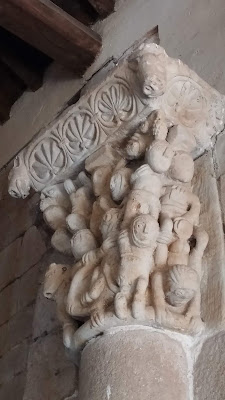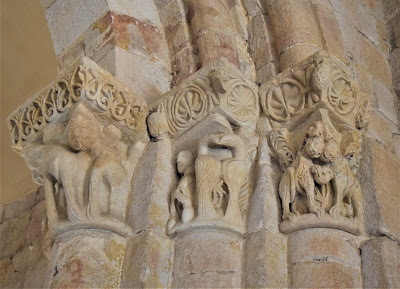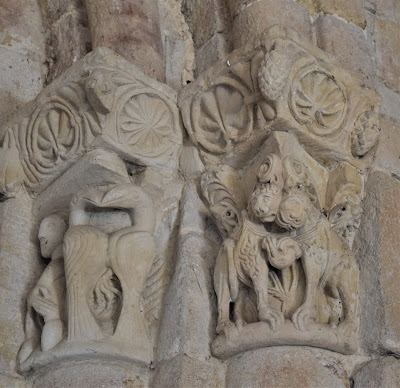 |
| Santiago de los Caballeros in the middle of the Field of Truth, seen from the castle Photos in this post 2017, 2018, 2019 Jessica Knauss |
It's known as St. James of the Knights because throughout the Middle Ages, this was where squires came to do a nightlong vigil and be knighted in a ceremony the following day. The current structure has elements from the beginning of the twelfth century. The rudimentary north and western facades (seen above) are likely hasty reconstructions from the late twelfth century and later. Like other Romanesque churches here, it's made from lovely golden and rose-colored local stones. From afar, it looks small, an impression that doesn't change as you come closer.
 |
| Santiago's "good side" has the intact early twelfth-century apse. |
When I pointed out Santiago de los Caballeros and its connections to the famous hero, my friend said, "I didn't know El Cid was in Zamora." Come on, the first half of the El Cid film takes place in Zamora! Zamora, an open secret of spectacular history.
 |
| Santiago de los Caballeros below the castle and cathedral bell tower |
 |
| That's the caretaker. |
Looking toward the foot, picture the plaster-covered walls replete with colorful paintings and you'll have a better idea of what Santiago was like when it was first built and used.
The lack of features in the rest of the building puts the focus on the parts that come to us directly from the early twelfth century: columns that might once have supported an arch, complete with capitals that are unique in Zamora; a triumphal arch some critics have said looks more like a doorway; and the tiny semicircular apse.
As usual, the meaty art is in the column capitals. The two large capitals before the apse both have simas with leaves, vines, and compressed palms not unlike the ones in San Claudio de Olivares. Many critics believe this is Asturian influence. To my eyes, it looks like a natural continuation of the sima tradition seen first in San Pedro de la Nave.
This first capital is worth viewing from every angle, such is the inscrutable confusion of forms.
 Every interpretation I've read claims that this is a sculptural representation of Hell, complete with all manner of fornication. Is it Hell, or the earthly behavior that leads to that low place? Before reading about this capital, I thought it was acrobats, a popular subject in Romanesque sculpture with multiple interpretations. Given the chaotic nature of the composition, it's likely the most negative connotations are the correct ones. Acrobats could indeed represent sins of the flesh, but looking closer, the sins appear to be represented literally.
Every interpretation I've read claims that this is a sculptural representation of Hell, complete with all manner of fornication. Is it Hell, or the earthly behavior that leads to that low place? Before reading about this capital, I thought it was acrobats, a popular subject in Romanesque sculpture with multiple interpretations. Given the chaotic nature of the composition, it's likely the most negative connotations are the correct ones. Acrobats could indeed represent sins of the flesh, but looking closer, the sins appear to be represented literally.
The inclusion of a horse on the side and heads of oxen in the sima further emphasize the theme of humans committing the sin of surrendering to their animal nature. I adore the numerous faces, the honest execution, and the inventiveness of the forms. Call me lurid, but this may be my favorite capital in Zamora.
Some Romanesque churches like to balance out the themes in their capitals by portraying opposite concepts across the aisle. Not so here. Clearly done by the same delightful artist, this capital shows the consequences of the actions in the first. The flames of Hell rise out of an Asturian-inspired rope decoration. Ropes are a continued theme as the tortured souls appear to be tied to the exotic beasts that punish them, with obvious allegorical value.
This poor fellow appears to be giving his tormentor a hug while it gnaws his hands off. This particular scene could have a subconnotation of the way time consumes all living things. But time is hardly a factor when you're enduring the eternal torments of the damned.
Turning our attention to the apse, the semicircular arch over the quadrilateral structure of the columns makes a perfect metaphor for the union between heaven and earth. The semicircular apse has three small windows and a stone checkerboard border. A simple table altar stands over the Renaissance tomb of one of Zamora's bishops. It would be hard to cram more sacredness into this limited space. During one of my visits here, I found this view to be as useful to a meditative state as a view of nature.
The triumphal arch has three fractional columns on each side, and their capitals line up in a row. On the left, delicately carved plant decorations that echo the simas, Adam and Eve after the original sin with the Serpent winding around them like a boa constrictor, and the expulsion from Eden.
The Adam and Eve figures are strange and rudimentary, but the serpent symbolism is original. In this view, we see the other side of the expulsion capital, which has facing lions. Remember them.
What's left of Adam and Eve in the expulsion from Eden is again crudely executed, in the same style as the serpent capital. Rather than merely covering themselves with found objects, however, we can see Eve is wearing a tunic that, while basic, doesn't have to be held together with the hands. She still modestly crosses her arms in front.
On the opposite side, the same artist placed indistinct four-legged beasts, facing birds and a man, and facing lions in a jungle-like scene. The enigmatic man appears to be protected by the birds, barely visible behind them. Birds can be representations of the human soul, or they can protect the human soul, which is sometimes symbolized with an anonymous human being. I like this interpretation because the man's pleasant expression indicates he has no worries: these birds are protecting him.
The lions in this group are the best sculptures in the church. The lions on the other side appear to be rough drafts, and these the final development. Here we can see why the lion came to be called "king of the jungle." But the leaves and branches here aren't meant to represent just any plant. These lions are guarding the Tree of Life. Nobody's getting past those fearsome claws!
Santiago de los Caballeros is in use today. It's served by the same priest who gives mass in neighboring San Claudio de Olivares. It has endured the ravages of weather for about 900 years. For two years, I've had the honor of sharing space with it. Let's see how much longer we both last!
The lack of features in the rest of the building puts the focus on the parts that come to us directly from the early twelfth century: columns that might once have supported an arch, complete with capitals that are unique in Zamora; a triumphal arch some critics have said looks more like a doorway; and the tiny semicircular apse.
This first capital is worth viewing from every angle, such is the inscrutable confusion of forms.
 Every interpretation I've read claims that this is a sculptural representation of Hell, complete with all manner of fornication. Is it Hell, or the earthly behavior that leads to that low place? Before reading about this capital, I thought it was acrobats, a popular subject in Romanesque sculpture with multiple interpretations. Given the chaotic nature of the composition, it's likely the most negative connotations are the correct ones. Acrobats could indeed represent sins of the flesh, but looking closer, the sins appear to be represented literally.
Every interpretation I've read claims that this is a sculptural representation of Hell, complete with all manner of fornication. Is it Hell, or the earthly behavior that leads to that low place? Before reading about this capital, I thought it was acrobats, a popular subject in Romanesque sculpture with multiple interpretations. Given the chaotic nature of the composition, it's likely the most negative connotations are the correct ones. Acrobats could indeed represent sins of the flesh, but looking closer, the sins appear to be represented literally.The inclusion of a horse on the side and heads of oxen in the sima further emphasize the theme of humans committing the sin of surrendering to their animal nature. I adore the numerous faces, the honest execution, and the inventiveness of the forms. Call me lurid, but this may be my favorite capital in Zamora.
Some Romanesque churches like to balance out the themes in their capitals by portraying opposite concepts across the aisle. Not so here. Clearly done by the same delightful artist, this capital shows the consequences of the actions in the first. The flames of Hell rise out of an Asturian-inspired rope decoration. Ropes are a continued theme as the tortured souls appear to be tied to the exotic beasts that punish them, with obvious allegorical value.
This poor fellow appears to be giving his tormentor a hug while it gnaws his hands off. This particular scene could have a subconnotation of the way time consumes all living things. But time is hardly a factor when you're enduring the eternal torments of the damned.
Turning our attention to the apse, the semicircular arch over the quadrilateral structure of the columns makes a perfect metaphor for the union between heaven and earth. The semicircular apse has three small windows and a stone checkerboard border. A simple table altar stands over the Renaissance tomb of one of Zamora's bishops. It would be hard to cram more sacredness into this limited space. During one of my visits here, I found this view to be as useful to a meditative state as a view of nature.
The triumphal arch has three fractional columns on each side, and their capitals line up in a row. On the left, delicately carved plant decorations that echo the simas, Adam and Eve after the original sin with the Serpent winding around them like a boa constrictor, and the expulsion from Eden.
The Adam and Eve figures are strange and rudimentary, but the serpent symbolism is original. In this view, we see the other side of the expulsion capital, which has facing lions. Remember them.
What's left of Adam and Eve in the expulsion from Eden is again crudely executed, in the same style as the serpent capital. Rather than merely covering themselves with found objects, however, we can see Eve is wearing a tunic that, while basic, doesn't have to be held together with the hands. She still modestly crosses her arms in front.
On the opposite side, the same artist placed indistinct four-legged beasts, facing birds and a man, and facing lions in a jungle-like scene. The enigmatic man appears to be protected by the birds, barely visible behind them. Birds can be representations of the human soul, or they can protect the human soul, which is sometimes symbolized with an anonymous human being. I like this interpretation because the man's pleasant expression indicates he has no worries: these birds are protecting him.
The lions in this group are the best sculptures in the church. The lions on the other side appear to be rough drafts, and these the final development. Here we can see why the lion came to be called "king of the jungle." But the leaves and branches here aren't meant to represent just any plant. These lions are guarding the Tree of Life. Nobody's getting past those fearsome claws!
Santiago de los Caballeros is in use today. It's served by the same priest who gives mass in neighboring San Claudio de Olivares. It has endured the ravages of weather for about 900 years. For two years, I've had the honor of sharing space with it. Let's see how much longer we both last!























































